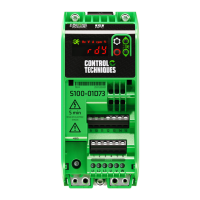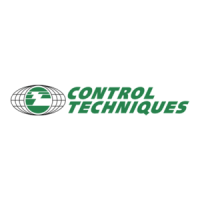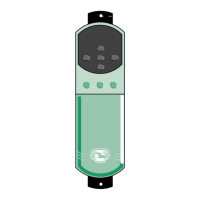1 Commander S100 Step by Step Guide
Important safety information
This variable speed drive product (drive) is intended for professional incorporation into complete equipment or systems. If installed incorrectly
it may present a safety hazard. The product uses high voltages and currents, carries a high level of stored electrical energy, and is used to
control mechanical plant which can cause injury. Close attention is required to the electrical installation and the system design to avoid
hazards either in normal operation or in the event of equipment malfunction. System design, installation, commissioning and maintenance
must be carried out by personnel who have the necessary training and experience. They must read this safety information and the instruction
manual carefully.
1 Enclosure The drive is intended to be mounted in an enclosure which prevents access except by trained and authorised personnel,
and which prevents the ingress of contamination. It is designed for use in an environment classified as pollution degree 2 in accordance with
IEC 60664-1. This means that only dry, non-conducting contamination is acceptable.
2 Lifting and handling Use appropriate safeguards when lifting these models. A full list of drive weights can be found in STEP 1.
3 Terminal connections and torque settings Loose power connections are a fire risk. Always ensure that terminals are
tightened to the specified torques. Refer to the tables in the relevant sections of this document.
4 General warning The voltages used in the unit can cause severe electric shock and/or burns, and could be lethal. Extreme care is
necessary at all times when working with or adjacent to it. The installation must comply with all relevant safety legislation in the country of use.
5 Isolation device The AC supply must be removed from the drive using an approved isolation device before any servicing work is
performed, other than adjustments to the settings or parameters specified in the manual. The drive contains capacitors which remain charged
to a potentially lethal voltage after the supply has been removed. Allow at least 10 minutes from removing the supply until carrying out any
work which may involve contact with electrical connections to the drive.
6 Products connected by plug and socket A special hazard may exist where the drive is incorporated into a product
which is connected to the supply by a plug and socket. When unplugged, the pins of the plug may be connected to the drive input, which is
separated from the charge stored in the capacitor only by semiconductor devices. To avoid any possibility of electric shock from the pins, if
they are accessible, a means must be provided for automatically isolating the plug from the drive - e.g. a latching contactor.
7 Grounding / Earthing The drive must be grounded by a conductor sufficient to carry the prospective fault current in the event of a
fault. The ground connections shown in the manual must be adhered to. The ground loop impedance must conform to the requirements of
local safety regulations. The ground connections must be inspected and tested at appropriate intervals.
8 Fuses The AC supply to the drive must be installed with suitable protection against overload. Failure to observe this requirement will
cause risk of fire. Integral solid-state short circuit protection does not provide branch circuit protection. Branch circuit protection must be
provided in accordance with the National Electrical Code (NEC), The Canadian Electrical Code, and any additional local codes. Opening of
the branch-circuit protective device may be an indication that a fault has been interrupted. To reduce the risk of fire or electric shock, the
equipment should be examined and replaced if damaged. If burnout of the current element of an overload relay occurs, the complete overload
relay must be replaced.
9 Over-current protection The devices incorporate solid state overload protection for the motor load. The protection levels are
expressed as a percentage of full-load current. For the motor protection to work properly, the motor rated current must be entered into P0.06
or P3.01. The protection level may be adjusted below 150 % if required. Refer to the User Guide for further information. All models are
provided with thermal memory retention.
10 Isolation of control circuits The control circuits are isolated from the power circuits in the drive by basic insulation only. The
installer must ensure that the external control circuits are insulated from human contact by at least one layer of insulation rated for use at the
AC supply voltage. If the control circuits are to be connected to other circuits classified as Safety Extra Low Voltage (SELV) - for example, to a
personal computer - an additional isolating barrier must be included in order to maintain the SELV classification.
11 Setting up, commissioning and maintenance It is essential that changes to the drive settings are given careful
consideration. Depending on the application, a change could result in unexpected motor behaviour. Appropriate precautions must be taken
against inadvertent changes or tampering. Some specific settings which require particular care are: automatic start (the drive may start
unexpectedly in this mode); restore default parameter set (depending on the application this may cause unpredictable or hazardous
operation); motor parameters (overheating and possible fire risk could result from seriously incorrect settings).
12 Safety of machinery, and safety-critical applications Within the European Union all machinery in which this
product is used must comply with Machinery Directive 2006/42/EC. The drive hardware and software are designed and tested to a high
standard, and failures are very unlikely. The level of integrity offered by the drive control functions (i.e. stop/start, forward/reverse and
maximum speed) is not sufficient for use in safety-critical applications without additional independent channels of protection. All applications
where malfunction could cause injury or loss of life must be subject to a risk assessment, and further protection provided where needed. The
design of safety-related control systems must only be done by personnel with the required training and experience. The system must be
subject to a risk assessment to confirm that the residual risk of an unsafe event is at an acceptable level for the application.
13 Electromagnetic compatibility (EMC) The product is designed to high standards of EMC, and data is provided in the
EMC data sheet. Under extreme conditions the product might cause or suffer from disturbance due to electromagnetic interaction with other
equipment. It is the responsibility of the installer to ensure that the equipment or system into which the product is incorporated complies with
the relevant EMC legislation in the country of use. Within the European Union, equipment into which this product is incorporated must comply
with the Electromagnetic Compatibility Directive 2014/30/EU.
14 Repairs Users must not attempt to repair a drive if it is faulty. It must be returned to the supplier of the drive.
The UL file reference is: NMMS/7.E171230.
The product is UL listed for use on a circuit up to 10 kA maximum supply symmetrical fault
current, when protected by fuses. 600 Volts AC Maximum.

